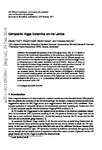Composite Higgs Dynamics on the Lattice
| dc.contributor.author | Pica, C | |
| dc.contributor.author | Drach, V | |
| dc.contributor.author | Hansen, M | |
| dc.contributor.author | Sannino, F | |
| dc.date.accessioned | 2017-09-08T13:58:40Z | |
| dc.date.available | 2017-09-08T13:58:40Z | |
| dc.date.issued | 2017 | |
| dc.identifier.issn | 2100-014X | |
| dc.identifier.issn | 2100-014X | |
| dc.identifier.other | ARTN 10005 | |
| dc.identifier.uri | http://hdl.handle.net/10026.1/9904 | |
| dc.description | 11 pages, 6 figures, prepared for the proceedings of the "XIIth Quark Confinement and the Hadron Spectrum" conference | |
| dc.description.abstract |
We investigate the spectrum of the SU(2) gauge theory with Nf = 2 flavors of fermions in the fundamental representation, in the continuum, using lattice simulations. This model provides a minimal template which has been used for different strongly coupled extensions of the Standard Model ranging from composite (Goldstone) Higgs models to intriguing types of dark matter candidates, such as the SIMPs. Here we will focus on the composite Goldstone Higgs paradigm, for which this model provides a minimal UV complete realization in terms of a new strong sector with fermionic matter. After introducing the relevant Lattice methods used in our simulations, we will discuss our numerical results. We show that this model features a SU(4)/Sp(4) ∼ SO(6)/SO(5) flavor symmetry breaking pattern, and estimate the value of its chiral condensate. Finally, we present our results for the mass spectrum of the lightest spin one and zero resonances, analogue to the QCD ρ, a1, σ η′, a0, resonances, which are relevant for searches of new, exotic resonances at the LHC. | |
| dc.format.extent | 10005-10005 | |
| dc.language.iso | en | |
| dc.publisher | EDP Sciences | |
| dc.subject | 5106 Nuclear and Plasma Physics | |
| dc.subject | 5107 Particle and High Energy Physics | |
| dc.subject | 51 Physical Sciences | |
| dc.title | Composite Higgs Dynamics on the Lattice | |
| dc.type | journal-article | |
| dc.type | Proceedings Paper | |
| plymouth.author-url | http://arxiv.org/abs/1612.09336v1 | |
| plymouth.volume | 137 | |
| plymouth.publisher-url | http://dx.doi.org/10.1051/epjconf/201713710005 | |
| plymouth.publication-status | Published | |
| plymouth.journal | EPJ Web of Conferences | |
| dc.identifier.doi | 10.1051/epjconf/201713710005 | |
| plymouth.organisational-group | /Plymouth | |
| plymouth.organisational-group | /Plymouth/Faculty of Science and Engineering | |
| plymouth.organisational-group | /Plymouth/Faculty of Science and Engineering/School of Engineering, Computing and Mathematics | |
| plymouth.organisational-group | /Plymouth/REF 2021 Researchers by UoA | |
| plymouth.organisational-group | /Plymouth/REF 2021 Researchers by UoA/EXTENDED UoA 10 - Mathematical Sciences | |
| plymouth.organisational-group | /Plymouth/REF 2021 Researchers by UoA/UoA10 Mathematical Sciences | |
| plymouth.organisational-group | /Plymouth/Users by role | |
| plymouth.organisational-group | /Plymouth/Users by role/Academics | |
| dc.identifier.eissn | 2100-014X | |
| dc.rights.embargoperiod | Not known | |
| rioxxterms.versionofrecord | 10.1051/epjconf/201713710005 | |
| rioxxterms.licenseref.uri | http://www.rioxx.net/licenses/all-rights-reserved | |
| rioxxterms.type | Journal Article/Review |


